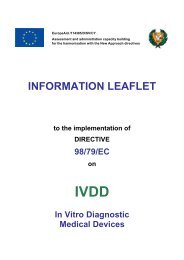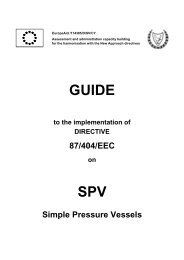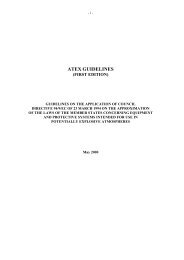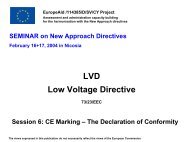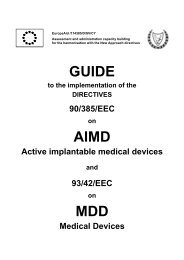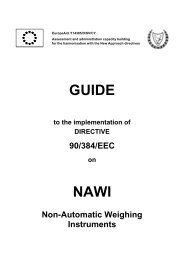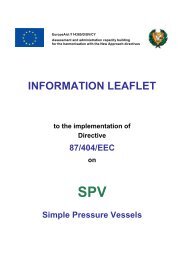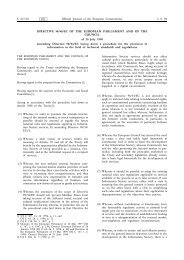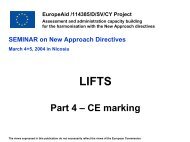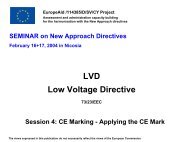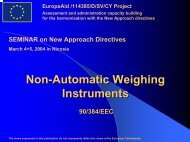The Recreational Craft Directive
The Recreational Craft Directive
The Recreational Craft Directive
You also want an ePaper? Increase the reach of your titles
YUMPU automatically turns print PDFs into web optimized ePapers that Google loves.
EuropeAid /114385/D/SV/CY Project<br />
Assessment and administration capacity building<br />
for the harmonisation with the New Approach directives<br />
SEMINAR on New Approach <strong>Directive</strong>s<br />
March 8+9, 2004 in Nicosia<br />
ATEX <strong>Directive</strong><br />
RC<br />
<strong>Recreational</strong> <strong>Craft</strong> <strong>Directive</strong><br />
94/25/EC<br />
<strong>The</strong> views expressed in this publication do not necessarily reflect the views of the European Commission.
Session 1
What is the RCD?<br />
• Results from internet search for “RCD”<br />
1 Radio Controller Devices<br />
2 Residual Current Device<br />
3 Real Club Deportivo<br />
4 Rassemblement Constitutionnel Démocratique<br />
5 Rabbit Calicivirus Disease<br />
6 Restorative & Cosmetic Dentistry<br />
• <strong>The</strong> “RCD” is not well known<br />
– even to the European boating industry!
<strong>The</strong> RCD is…...<br />
• Legislation setting minimum safety standards<br />
• Current Scope:<br />
–Annex I:<br />
<strong>Recreational</strong> craft from 2.5m to 24m hull length<br />
– Annex II:<br />
Key components of recreational craft:<br />
– Fuel tanks & hoses<br />
– Steering system components<br />
– Hatches & portlights<br />
– Start-in-gear protection (for outboard motors)<br />
– Ignition protected (electrical components)
Key Dates<br />
• Laid before Parliament: 16 June 1994<br />
• Adoption by Member states: 16 June 1995<br />
• Coming into force: 16 June 1996<br />
– Compliance with RCD optional from this point<br />
• Implementation: 16 th June 1998<br />
– Mandatory from this point
Why the RCD?<br />
• <strong>The</strong> boat builders asked for RCD<br />
• Difficulties in trading boats across Europe<br />
• Allegations of market protectionism within<br />
the “single market”<br />
• UK was one of the most keen nations<br />
– Resulting <strong>Directive</strong> more than expected<br />
• Note: these are not safety concerns!
<strong>Craft</strong> Excluded from RCD Scope:<br />
1<br />
• craft intended solely for racing<br />
– including rowing racing boats and training<br />
rowing boats labelled as such by the<br />
manufacturer<br />
• canoes, kayaks, gondolas and pedalos;<br />
• sailing surfboards;<br />
• powered surfboards, personal watercraft and<br />
other similar powered craft;
<strong>Craft</strong> Excluded from RCD Scope<br />
• original, and individual replicas of,<br />
historical craft designed before 1950<br />
2<br />
– built predominantly with the original materials<br />
and labelled as such by the manufacturer;<br />
• experimental craft<br />
– provided that they are not subsequently placed<br />
on the Community market
<strong>Craft</strong> Excluded from RCD Scope<br />
3<br />
• craft built for own use<br />
– provided that they are not subsequently placed<br />
on the Community market for 5 years;<br />
• craft specifically intended to be crewed & to<br />
carry passengers for commercial purposes;<br />
• submersibles;<br />
• air cushion vehicles; or<br />
• hydrofoils.
Not All <strong>Craft</strong> Are Equal<br />
• Some are for river use, others cross oceans<br />
• Technical demands are not the same<br />
• Risk needs to be “categorised”<br />
• Level of risk needs to dictate:<br />
– Technical demands of Standards<br />
–Degree of 3 rd party certification/verification
RCD Design Categories<br />
• Defined by wave height & wind speed<br />
Ref. & Description Wave Height Beaufort<br />
• A – Ocean: > 4m > 8<br />
Must also be “largely self-sufficient”<br />
• B – Offshore: ≤ 4m ≤ 8<br />
• C – Inshore: ≤ 2m ≤ 6<br />
• D – Sheltered: ≤ 0.5m ≤ 4
Design Category<br />
Assessment Module<br />
C (Inshore)<br />
G
Design Category<br />
Assessment Module<br />
C (Inshore)<br />
A
Design Category<br />
Assessment Module<br />
C (Inshore)<br />
A
Design Category<br />
Assessment Module<br />
A (Ocean)<br />
B+C
Design Category<br />
Assessment Module<br />
A (Ocean)<br />
G
Design Category<br />
Assessment Module<br />
A (Ocean)<br />
G
Summary of Scope<br />
• <strong>Craft</strong> with hull length between 2.5m & 24m<br />
– <strong>Craft</strong> with certain “specific uses” are excluded<br />
– All craft must be assigned a Design (risk)<br />
Category<br />
• Key components of recreational craft
Amendment of RCD<br />
• Put before Council in 2003<br />
• First requirements mandatory 1 Jan. 2005<br />
• Scope changed to include:<br />
– Annex I: Personal Watercraft (PWC)<br />
• i.e. Jet-Skis<br />
– Annex II: Propulsion Engines
When does RCD apply?<br />
• <strong>The</strong> EU Product <strong>Directive</strong> Mantra:<br />
– “EU (product) <strong>Directive</strong>s apply at the first point<br />
of sale or first putting into service in the EEA”<br />
• Imposes RCD responsibility on:<br />
– Builders<br />
– Distributors<br />
– Owners
Session 2
Discharging RCD<br />
Responsibilities<br />
• A duty holder complies with the RCD when<br />
he/she can adequately demonstrate that the<br />
product meets the applicable Essential<br />
Safety Requirements<br />
• How does one adequately demonstrate?<br />
• What are Essential Safety Requirements?
Essential Safety Requirements<br />
• 30 in 5 sections:<br />
– Design:<br />
• Boat Design Categories<br />
• Integrity and Structural Requirements<br />
• Handling Characteristics<br />
– Production:<br />
• General Requirements<br />
• Installation Requirements
ESR Observations<br />
• Do not cover operation or usage<br />
– No requirement to carry safety equipment<br />
• Only need a suitable location for liferaft & fire extinguishers<br />
– No restrictions for usage:<br />
• to navigate within design category conditions<br />
• to remain within a given distance of shore<br />
• Not all ESRs are safety related<br />
– e.g. Hull Identification Number (HIN)<br />
• to provide identification after theft
ESR Observations - 2<br />
• ESRs are non-prescriptive in nature<br />
– e.g. ESR 3.1, Structure:<br />
• “<strong>The</strong> choice & combination of materials & its<br />
construction shall ensure that the craft is strong<br />
enough in all respects”<br />
• Very difficult to measure compliance
ESRs in Detail - 1<br />
• 2.1 Hull Identification<br />
– EN ISO 10087 Hull identification coding system<br />
– to become <strong>Craft</strong> ID (CIN) with amendment<br />
• Beware of dating a boat by the HIN<br />
• Beware of judging the country of origin from the HIN<br />
– Incomplete imports
Hull Identification Number
ESRs in Detail - 2<br />
• 2.2 Builder’s Plate<br />
– FDIS 14945 Builder’s plate - under amendment to resolve safety<br />
concerns regarding loading<br />
• 2.3 Protection from falling overboard and reboarding<br />
– “Designed to minimise the risk of falling overboard”<br />
– FDIS 15085 Man overboard prevention and recovery<br />
• 2.4 Visibility from the main steering position<br />
– “For motor boats, good all-round visibility”<br />
– EN ISO 11591 Engine-driven small craft - Field of vision
Demonstrations Needn’t be Clever
ESRs in Detail - 3<br />
• 2.5 Owner’s Manual<br />
– EN ISO 10240 Owner’s manual - Under revision<br />
• 3.1 Structure<br />
– “<strong>The</strong> choice and combination of materials and construction shall<br />
ensure the craft is strong enough in all respects”<br />
• 3.2 Stability and freeboard<br />
• “sufficient stability and freeboard for its design category”<br />
• 3.3 Buoyancy and flotation<br />
• “buoyancy characteristics appropriate” and “flotation required<br />
if less than 6m long and susceptible to swamping”
Design Category C (Inshore)<br />
Assessment Module Aa (now A)
ESRs in Detail - 4<br />
• 3.5 Flooding<br />
• “designed to minimise the risk of sinking”<br />
• 3.4 Openings in hull, deck and superstructure<br />
• “windows, doors and hatches shall withstand water pressure<br />
likely to be encountered”<br />
• 3.6 Manufacturers maximum recommended load<br />
• Currently “includes fuel, water, provisions, equipment and<br />
people, as marked on the Builder’s plate”<br />
• Amendment to <strong>Directive</strong> excludes fluids from Builder’s Plate
ESRs in Detail - 5<br />
• 4 Handling Characteristics<br />
• “<strong>The</strong> manufacturer shall ensure that the handling<br />
characteristics of the craft are satisfactory with the most<br />
powerful engine for which the boat is designed and<br />
constructed”<br />
• “maximum rated engine power shall be declared in the owner’s<br />
manual”<br />
• 5.1 Engines and engine space<br />
• “Installed to minimise risk of fire, hazards from fumes, noise”<br />
• “Engine compartment shall be ventilated”
ESRs in Detail - 6<br />
• 5.2 Fuel system<br />
• “designed to minimise risk of fire and explosion”<br />
• “insulated from engine compartment (petrol)”<br />
• 5.3 Electrical systems<br />
• “Installed to minimise risk of fire and electric shock”<br />
• 5.4 Steering systems<br />
• 5.5 Gas system<br />
• EN ISO 10239 LPG systems
ESRs in Detail - 7<br />
• 5.6 Fire protection<br />
• Amendment clarifies current practice: fire extinguishers need<br />
not be in place but location and capacity to be defined in<br />
Owners Manual<br />
• 5.7 Navigation lights<br />
– 1972 COLREG or CEVNI<br />
• 5.8 Discharge prevention<br />
– “provision for holding tanks”<br />
– A holding tank itself need not be fitted<br />
– Key requirement to “seal shut” the final discharge valve
Annex II Components<br />
• Ignition protected equipment for inboard and stern drive<br />
engines<br />
• Start-in-gear protection devices for outboard engines<br />
• Steering wheels, steering mechanisms and cable<br />
assemblies<br />
• Fuel tanks and fuel hoses - new standard for fuel tanks<br />
– Question over portable fuel tanks<br />
• Prefabricated hatches and portlights
Harmonised Standards<br />
• Created by CEN to support the <strong>Directive</strong><br />
• Different standards support different ESRs<br />
• Provide the prescriptive detail missing in the<br />
<strong>Directive</strong>’s ESRs<br />
• All EU member states must:<br />
– adopt these as their own National Standards<br />
– Remove any of their own conflicting standards<br />
• <strong>The</strong> standard is now “harmonised” across the EU
Harmonised Standards for RCD<br />
• Mostly one standard for each ESR<br />
• Easy to measure compliance:<br />
– Compliance with a standard = ESR
Design Category<br />
Assessment Module<br />
D (Sheltered)<br />
A
Alternatives to harmonised standards<br />
• Harmonised Standards are not mandatory<br />
• BUT harmonised standards carry a presumption of<br />
conformity<br />
– Nobody can dispute whether a boat complies with the<br />
<strong>Directive</strong> if it conforms to harmonised standards<br />
• Alternative solutions must demonstrate equivalent<br />
safety<br />
– Difficult to demonstrate beyond doubt<br />
– Any authority has the right to raise such a doubt<br />
– Unfamiliar features on a boat are likely to raise doubt<br />
• features that do not conform to harmonised standards will be<br />
presumed not to conform by inspectors
Session 3
Discharging RCD<br />
Responsibilities<br />
• A duty holder complies with the RCD when<br />
he/she can adequately demonstrate that the<br />
product meets the applicable Essential<br />
Safety Requirements<br />
• How does one adequately demonstrate?<br />
• What are Essential Safety Requirements?
Adequate Demonstration<br />
• Technical Construction File<br />
• Owners Manual<br />
• Declaration of Conformity<br />
• A Builder’s Plate with CE marking<br />
• Notified Body Certificate<br />
– for some craft
Technical Documentation<br />
• <strong>Directive</strong> says:<br />
– “Technical documentation shall enable the<br />
conformity of the products with the<br />
requirements of the <strong>Directive</strong> to be assessed. It<br />
shall, as far as relevant for such assessment,<br />
cover the design, manufacture and operation of<br />
the product.”
Technical Documentation - 2<br />
• Evidence of conformity to standards for each ESR<br />
• Descriptions - drawings/photos<br />
• Test results<br />
• Calculations<br />
– Details of alternative solutions with demonstrations of<br />
equivalent safety<br />
• A technical file must be produced for every model<br />
– unless a formal, certified quality system for design is<br />
operated by the builder – very rare!<br />
– <strong>The</strong> TCF must be held for 10 years
Owners Manual (OM)<br />
• Required by ESR 2.5<br />
• Must be provided with each boat<br />
• EN ISO 10240 defines contents and layout<br />
• Many harmonised standards suggest text for<br />
inclusion
Declaration of Conformity<br />
• <strong>The</strong> unequivocal statement of compliance<br />
with one or more directives<br />
• To include a list of applied standards<br />
• Signed by the builder or his representative<br />
who should be clearly identified<br />
• Must be provided with each boat<br />
• Standard Template recently issued<br />
– following lobbying by ICOMIA
Declaration of Conformity • <strong>Recreational</strong> <strong>Craft</strong> • directive 94/25/CE<br />
Name of the manufacturer<br />
__________________________________________________________________________________________<br />
Adress<br />
__________________________________________________________________________________________<br />
Zip code ___________________________ City _____________________________________________________<br />
Country (code) ___________(printed) _______________________________________________________________<br />
A _- Aa _ _ B+C _ - B+D _ _ B+F _ G _- H _ _<br />
Module used (check)<br />
IF THE DECLARATION IS MADE BY AN AUTORISED REPRESENTATIVE<br />
__________________________________________________________________________________________<br />
Authorised representative established in the EEA territory<br />
__________________________________________________________________________________________<br />
Adress<br />
_________________________________ ________________________________________________________<br />
Zip code<br />
City<br />
_____________________ ____________________________________________________________________<br />
Country (code) (printed)<br />
IF INTERVENTION OF A NOTIFIED BODY<br />
__________________________________________________________________________________________<br />
Name Code<br />
__________________________________________________________________________________________<br />
Adress<br />
_________________________________ ________________________________________________________<br />
Zip code:<br />
City<br />
_____________________ ____________________________________________________________________<br />
Country (code) (printed)<br />
________________________, ___ / ___ / ___<br />
If EC type-examination certificate has been issued (certificate number and date yr/mo/day)<br />
DESCRIPTION OF THE CRAFT<br />
Hull identification number (HIN) -<br />
_______________________________________________________________________________________________________________<br />
Brand name of the craft<br />
_______________________________________________________________________________________________________________<br />
Type or number<br />
.................................................................................................................................................................................................. :_____________<br />
Design category<br />
.................................................................................................................................................................................................. :_____________<br />
Type of boat<br />
.................................................................................................................................................................................................. :_____________<br />
Type of hull<br />
.................................................................................................................................................................................................. :_____________<br />
Deck<br />
.................................................................................................................................................................................................. :_____________<br />
Construction material<br />
.................................................................................................................................................................................................. :_____________<br />
Propulsion<br />
.................................................................................................................................................................................................. :_____________<br />
Type of engine<br />
.................................................................................................................................................................................................. :_____________<br />
Maximum recommended engine power (kW)<br />
...................................................................................................................................................................... :_____________/_____________<br />
Hull length and width (m)<br />
.................................................................................................................................................................................................. :_____________<br />
Draught (m)<br />
I declare at my own responsability that the boat mentioned above complies with all applicable essential requirements in the way specified on<br />
the opposite side<br />
_______________________________________________________________________________________________________________<br />
Name Printed<br />
___________________________________________
• Type of boat<br />
01 • sailboat<br />
02 • inflatable<br />
03 • other: _____________________________________<br />
Skrovtyp • Type of hull:<br />
01 • monohull<br />
02 • multihull<br />
03 • other: _____________________________________<br />
Konstruktionsmaterial • Construction material:<br />
01 • aluminium, aluminium alloys<br />
02 • plastic, fiber reinforced plastic<br />
03 • steel, steel alloys<br />
04 • wood<br />
05 • other: _____________________________________<br />
• Propulsion:<br />
01 • sails<br />
02 • petrol engine<br />
03 • diesel engine<br />
04 • electrical motor<br />
05 • oars<br />
06 • other: ____________________________________<br />
• type of engine:<br />
01 • outboard<br />
02 • inboard<br />
03 • z or sterndrive (embase relevable)<br />
04 • other: ____________________________________<br />
• Deck<br />
01 • decked<br />
02 • partly decked<br />
03 • open<br />
Essential requirements<br />
(ref. to relevant article in Annex 1 of the <strong>Directive</strong>)<br />
Harmonised standards used<br />
ISO-standards used<br />
Other normative document used<br />
See the technical file<br />
• General requrements (2)<br />
• Hull Identifikation Number – HIN (2.1)<br />
• Builder’s Plate (2.2)<br />
• Protection from falling overboard and means of reboarding (2.3)<br />
• Visibility from the main steering position (2.4)<br />
• Owner’s manual (2.5)<br />
• Structure (3.1)<br />
• Stability and freeboard (3.2)<br />
• Buoyancy and floatation (3.3)<br />
• Openings in hull, deck and superstructure (3.4)<br />
• Flooding (3.5)<br />
• Manufacturer’s maximum recommended load (3.6)<br />
• Liferaft stowage (3.7)<br />
• Escape (3.8)<br />
• Anchoring, mooring and towing (3.9)<br />
• Handling characteristics (4)<br />
• Engines and engine spaces (5.1)<br />
• Inboard engine (5.1.1)<br />
• Ventilation (5.1.2)<br />
• Exposed parts (5.1.3)<br />
• Outboard engine starting (5.1.4)<br />
• Fuel system (5.2)<br />
• General – fuel system (5.2.1)<br />
• Fuel tanks (5.2.2)<br />
• Electrical systems (5.3)<br />
• Steering systems (5.4)<br />
• General – steering system (5.4.1)<br />
• Emergency arrangements (5.4.2)<br />
• Gas systems (5.5)<br />
• Fire protection (5.6)<br />
• General – fire protection (5.6.1)<br />
• Navigation lights (5.7)<br />
• Discharge prevention (5.8)
<strong>The</strong> CE Marking<br />
Model Name<br />
Category C<br />
Max = 8<br />
Max + = 750 kg<br />
Max = 66 kW (90 hp)<br />
Max<br />
= 2.5 bar (36 p.s.i.)<br />
0466<br />
Manufacturer Name<br />
Address etc.
Summary of Requirements<br />
• A boat complies with the RCD when it can<br />
adequately demonstrate that it meets the<br />
applicable Essential Safety Requirements<br />
– Adequate Demonstration:<br />
• Technical Construction File<br />
• Owners Manual<br />
• Declaration of Conformity<br />
• A CE marking<br />
• For some craft, a certificate from a Notified Body
Notified Bodies - Description<br />
• Conformity Assessment Bodies (CAB)<br />
• Appointed for specific <strong>Directive</strong>(s)<br />
• Appointed for specific Modules<br />
• Issue certificates for compliant products
Appointment of NoBos<br />
1. <strong>The</strong> body, its director and the staff responsible for carrying<br />
out the verification tests shall not be the designer,<br />
manufacturer, supplier or installer of boat or components<br />
which they inspect, nor the authorized representative of<br />
any of these parties. <strong>The</strong>y shall not become either involved<br />
directly or as authorized representatives in the design,<br />
construction, marketing or maintenance of the said<br />
products. This does not preclude the possibility of<br />
exchanges of technical information between the<br />
manufacturer and the body.
Appointment of NoBos<br />
2 <strong>The</strong> body and its staff shall carry out the verification tests<br />
with the highest degree of professional integrity and<br />
technical competence and shall be free from all pressures<br />
and inducements, particularly financial, which might<br />
influence their judgement or the result of the inspection,<br />
especially from persons or groups of persons with an<br />
interest in the result of verifications.
Appointment of NoBos<br />
3. <strong>The</strong> body shall have at its disposal the necessary staff<br />
and possess the necessary facilities to enable it to<br />
perform properly the administrative and technical tasks<br />
connected with verification; it shall also have access to<br />
the equipment required for special verification.
Appointment of NoBos<br />
4. <strong>The</strong> staff responsible for inspection shall have:<br />
- sound technical and professional training,<br />
- satisfactory knowledge of the requirements of the tests<br />
they carry out and adequate experience of such tests,<br />
- the ability to draw up the certificates, records and<br />
reports required to authenticate the performance of the<br />
tests.
Appointment of NoBos<br />
5. <strong>The</strong> impartiality of inspection staff shall be guaranteed.<br />
<strong>The</strong>ir remuneration shall not depend on the number of<br />
tests carried out or on the results of such tests.
Appointment of NoBos<br />
6. <strong>The</strong> body shall take out liability insurance unless its<br />
liability is assumed by the State in accordance with<br />
national law, or the Member State itself is directly<br />
responsible for the tests.
Appointment of NoBos<br />
7. <strong>The</strong> staff of the body shall be bound to observe<br />
professional secrecy with regard to all information<br />
gained in carrying out its tasks (except vis-à-vis the<br />
competent administrative authorities of the State in<br />
which its activities are carried out) under the <strong>Directive</strong><br />
or any provision of national law giving effect to it.
Appointment of Notified Bodies<br />
• Required credentials:<br />
– Experienced in the industry<br />
– Independent from the industry<br />
– Able to deliver consistent service<br />
– Must operate in line with EN45000 series<br />
• Appointed by Government<br />
– Assessed by national accreditation service<br />
• Government “notifies” Commission
Notified Bodies - Operation<br />
• Commission issues ID number & circulates<br />
news of appointment<br />
• Appointing Government responsible for<br />
ongoing assessment of Notified Body<br />
• Body may trade world-wide<br />
• Decisions of Notified Body must be<br />
recognised throughout Europe<br />
– unless there is reason to suspect error
Summary<br />
• Scope & Exclusions<br />
• Compliance with harmonised standards =<br />
Compliance with <strong>Directive</strong><br />
• Documentation to demonstrate compliance<br />
•CE Marking<br />
• Notified Body Certificate?
Conformity Assessment Modules<br />
• Choice of Conformity Assessment Modules<br />
Category<br />
L H
Modules - Full Range<br />
Module<br />
A<br />
Aa<br />
B +<br />
+ C<br />
+ D<br />
+ F<br />
G<br />
H<br />
Design<br />
NB review TCF<br />
-<br />
NB review TCF<br />
Production<br />
Manufacturer’s internal control<br />
Manufacturer’s internal control<br />
-<br />
NB audit Quality Systems<br />
Stability<br />
Testing<br />
NB test prototype<br />
NB test prototype<br />
Manufacturer’s internal control<br />
NB audit Quality Systems<br />
NB to inspect samples of production<br />
NB inspect & test every unit
Modules - Useful Range!<br />
Module<br />
A<br />
Aa<br />
B +<br />
+ C<br />
G<br />
Design Production<br />
Manufacturer’s internal control<br />
Stability<br />
Testing<br />
Manufacturer’s internal control NB test prototype<br />
NB review TCF<br />
-<br />
NB test prototype<br />
-<br />
Manufacturer’s internal control<br />
NB review TCF NB inspect & test every unit
Module A (Annex V)<br />
INTERNAL PRODUCTION CONTROL<br />
• <strong>The</strong> manufacturer or his authorized representative ensures<br />
and declares that the products concerned satisfy the<br />
requirements of the <strong>Directive</strong><br />
• affix the CE marking to each product<br />
• draw up a written declaration of conformity<br />
• establish the technical documentation<br />
– and keep it for a period ending at least 10 years<br />
• take measures necessary to ensure compliance of the<br />
manufactured products with the technical<br />
documentation
Module Aa (Annex VI)<br />
INTERNAL PRODUCTION CONTROL + TESTS<br />
• As Module A +<br />
• Following tests, calculation or control shall be<br />
carried out by the manufacturer or on his behalf:<br />
– test of stability according to ESR 3.2<br />
– test of buoyancy characteristics according ESR 3.3<br />
• To be carried out on the responsibility of a notified<br />
body<br />
– chosen by the manufacturer.<br />
• On the responsibility of the notified body, the<br />
manufacturer shall affix the former's distinguishing<br />
number during the manufacturing process.
Module B (Annex VII)<br />
EC TYPE EXAMINATION<br />
• A notified body ascertains and attests that a specimen,<br />
representative of the production envisaged, meets the<br />
provisions of the <strong>Directive</strong> that apply to it.<br />
– <strong>The</strong> application for EC type-examination shall be<br />
lodged with a notified body & include:<br />
• a written declaration that the same application has not been<br />
lodged with any other notified body,<br />
• the technical documentation<br />
– <strong>The</strong> applicant shall place a specimen of the “type” at<br />
the disposal of the notified body<br />
– <strong>The</strong> notified body may request further specimens if<br />
needed for carrying out the test programme.
Module B (Annex VII)<br />
EC TYPE EXAMINATION<br />
• <strong>The</strong> notified body shall:<br />
– examine the technical documentation,<br />
– verify that the type has been manufactured in<br />
conformity with the technical documentation<br />
– perform or have performed the appropriate<br />
examinations and necessary tests<br />
– (if compliant) issue an EC type-examination<br />
certificate
Module B (Annex VII)<br />
EC TYPE EXAMINATION<br />
• If the manufacturer is denied a type<br />
certification, the notified body shall provide<br />
detailed reasons for such denial.<br />
• <strong>The</strong> applicant shall inform the notified body<br />
of all modifications to the approved product<br />
which must receive additional approval.
Module C (Annex VIII)<br />
CONFORMITY TO TYPE<br />
• <strong>The</strong> manufacturer or his authorized representative<br />
declares that the products care in conformity with the type<br />
as described in the EC type-examination certificate and<br />
satisfy the requirements of the <strong>Directive</strong> that applies to<br />
them.<br />
– <strong>The</strong> manufacturer shall:<br />
– affix the CE marking to each product<br />
– draw up a written declaration of conformity<br />
– take measures necessary to ensure the manufacturing<br />
process assures compliance of the products with the<br />
type as described in the EC type-examination<br />
certificate.
Module G (Annex XI)<br />
UNIT VERIFICATION<br />
• <strong>The</strong> manufacturer ensures and declares that the product<br />
concerned, which has been issued with the certificate<br />
referred to in point 2, conforms to the requirements<br />
• <strong>The</strong> manufacturer shall:<br />
– affix the CE marking to each product<br />
– draw up a written declaration of conformity<br />
• <strong>The</strong> notified body shall:<br />
– examine the individual product and carry out tests<br />
– affix, or cause to be affixed, its distinguishing number<br />
– draw up a certificate of conformity
Other Modules<br />
• D - Production Quality Assurance (Annex IX)<br />
– similar to ISO 9002<br />
• F - Product Verification (Annex X)<br />
– Sampling of production by Notified Body<br />
• H - Full Quality Assurance (Annex XII)<br />
– Similar to ISO 9001
Modular Choice<br />
• Modules must be applied as shown<br />
Category<br />
L H
Session 4
Summary of the Process<br />
1. Select<br />
Design Category<br />
2. Select Module<br />
5. Compile Technical<br />
Documentation<br />
6. Notified<br />
Body Certificate<br />
3. Contract<br />
Notified Body ??<br />
7. Sign Declaration<br />
of Conformity<br />
4. Comply with<br />
harmonised standards<br />
8. Affix<br />
CE Mark
Part Built Boats<br />
• Annex IIIa Declaration<br />
– from each builder in the chain of production<br />
• Declaration must contain details of the work<br />
undertaken and the standards applied<br />
• <strong>Craft</strong> may not be CE marked until<br />
completion<br />
• HIN could be issued by any party in the<br />
production chain
Difficulties of Application<br />
• New & Global Approach <strong>Directive</strong>s apply<br />
same principals to a wide range of products<br />
• But boats are different:<br />
– Designed to move between nations<br />
• in and out of EEA<br />
– Commonplace for owners to home-build
Anomalies of RCD Scope<br />
• Home-Built Boats<br />
• Boats built from “kits”<br />
• Conversions (e.g. ex racing craft)<br />
• Boats imported from outside EU<br />
• Boats visiting from outside EU<br />
• How to prove a craft is excluded from RCD?
Home-Built Boats<br />
• Only excluded when not sold for 5 years<br />
after completion<br />
– Not excluded during the 5 years<br />
• Transfer of ownership constitutes a “sale”<br />
– even if no money changes hands<br />
• A CE mark enhance re-sale value<br />
– particularly for home-built boats where builder<br />
has no reputation
Kit Boats<br />
• RCD has no special requirements<br />
• Following options apply:<br />
– Manufacturer may issue CE marks<br />
• where satisfied of build quality<br />
• Up to manufacturer as to how satisfaction is<br />
measured!<br />
– Assemblers may affix their own CE mark
Conversions<br />
• If craft are modified such that<br />
– their designed mode of operation changes<br />
• e.g. commercial barge refitted for leisure use<br />
– they are effectively a new craft<br />
• they should comply with RCD
Boats from outside EU<br />
• Compliance is required post construction:<br />
• If put into service in the EEA for the first time after<br />
June 1998<br />
• If put on the market in EEA for the first time after<br />
June 1998<br />
• If built after 1950<br />
• Compliance not required if boat has been in<br />
service in EU waters before June 1998<br />
• EU waters includes dependencies!<br />
• Person importing the craft is responsible<br />
• Could be the owner or distributor
List of EU & EEA Members<br />
•Austria<br />
• Belgium<br />
• Denmark<br />
• Finland<br />
•France<br />
• Germany<br />
• Greece<br />
• Iceland (EEA)<br />
• Italy<br />
• Ireland (Eire)<br />
• Leichtenstein (EEA)<br />
• Luxembourg<br />
• Netherlands<br />
• Norway (EEA)<br />
• Portugal<br />
• Spain<br />
• Sweden (1995)<br />
• United Kingdom
EU Dependencies<br />
• Anguilla<br />
• Aruba<br />
• Azores<br />
• Bermuda<br />
• British Antarctic Territory<br />
• British Indian Ocean Territory<br />
• British Virgin Islands<br />
• Canary Islands<br />
• Cayman Islands<br />
• Falkland Islands<br />
• French overseas Departments<br />
• French Polynesia<br />
• French Southern and Antarctic<br />
Territories<br />
• Greenland<br />
• Madeira<br />
• Montserrat<br />
• Mayotte<br />
• Netherlands Antilles:<br />
• Bonaire<br />
• Curaçao<br />
• Saba<br />
• Sint Eustatius<br />
• Sint Maarten<br />
• New Caledonia and Dependencies<br />
• Pitcairn<br />
• Saint Helena and Dependencies<br />
• Saint Pierre and Miquelon<br />
• South Georgia & South Sandwich<br />
Islands<br />
• Turks and Caicos Islands<br />
• Wallis and Futuna Islands
Boats Visiting from outside EU<br />
• Compliance is required:<br />
– on first point of sale in EEA<br />
– on first putting on the market in EEA<br />
• Contrary to GATT<br />
• Now accepted that craft “in transit” through<br />
EEA waters do not need to comply<br />
– No definition “in transit”<br />
– Court will rule!
Proving Exemption<br />
• <strong>Craft</strong> must either be compliant or exempt<br />
– there is no “third way”<br />
• Procedure for compliance is well<br />
documented<br />
• <strong>The</strong> RCD includes no protocol for proving<br />
exemption<br />
– Owners can be questioned about a lack of CE<br />
marking at every EU port of call
Summary of Scope<br />
• <strong>The</strong> RCD can be applicable to:<br />
– <strong>Craft</strong> built before June 1998 as well as after<br />
– New-builds & existing craft<br />
– Home & professionally built craft<br />
– <strong>Recreational</strong> craft & boats belonging to racing classes<br />
• This means that any craft MIGHT have to comply!<br />
– One can’t decide if a boat falls within RCD scope by<br />
looking at it<br />
– <strong>The</strong> history of each case must be considered
RCD Reflections<br />
• RCD perceived as a straight-jacket<br />
• In fact the New & Global Approach allows<br />
for significant flexibility<br />
• Only the HIN standard is mandatory<br />
• Alternative solutions need justification<br />
• Notified Bodies do not like “justification”<br />
• Few take-up the flexibility on offer
Session 5
Summary of Day 1<br />
• Scope<br />
•Exclusions<br />
• Design Categories<br />
• Essential Safety Requirements<br />
• Conformity Assessment Modules<br />
• Documentation<br />
• Notified Bodies
Scope<br />
• All craft for recreational usage:<br />
– with hull length 2.5m to 24m
Exclusions<br />
• Long list of exclusions (refer to <strong>Directive</strong>)<br />
• Most exclusions fall into two categories:<br />
–<strong>Craft</strong> only for specific non-recreational use:<br />
•racing<br />
• commercial use<br />
– Odd craft:<br />
• Experimental<br />
• Historical replicas<br />
• Hydrofoils, ACV (hovercraft) etc.
RCD Design Categories<br />
• Defined by wave height & wind speed<br />
Ref. & Description Wave Height Beaufort<br />
• A – Ocean: > 4m > 8<br />
Must also be “largely self-sufficient”<br />
• B – Offshore: ≤ 4m ≤ 8<br />
• C – Inshore: ≤ 2m ≤ 6<br />
• D – Sheltered: ≤ 0.5m ≤ 4
Essential Safety Requirements<br />
• 30 in 5 sections:<br />
– Design:<br />
• Boat Design Categories<br />
• Integrity and Structural Requirements<br />
• Handling Characteristics<br />
– Production:<br />
• General Requirements<br />
• Installation Requirements
ESR Observations<br />
• Do not cover operation or usage<br />
– No requirement to carry safety equipment<br />
• Only need a suitable location for liferaft & fire extinguishers<br />
– No restrictions for usage:<br />
• to navigate within design category conditions<br />
• to remain within a given distance of shore<br />
• Not all ESRs are safety related<br />
– e.g. Hull Identification Number (HIN)<br />
• to provide identification after theft
Conformity Assessment Modules<br />
• Choice of Conformity Assessment Modules<br />
Category<br />
L H
Modules - Full Range<br />
Module<br />
A<br />
Aa<br />
B +<br />
+ C<br />
+ D<br />
+ F<br />
G<br />
H<br />
Design<br />
NB review TCF<br />
-<br />
NB review TCF<br />
Production<br />
Manufacturer’s internal control<br />
Manufacturer’s internal control<br />
-<br />
NB audit Quality Systems<br />
Stability<br />
Testing<br />
NB test prototype<br />
NB test prototype<br />
Manufacturer’s internal control<br />
NB audit Quality Systems<br />
NB to inspect samples of production<br />
NB inspect & test every unit
Documentation<br />
• Technical Construction File<br />
• Owners Manual<br />
• Declaration of Conformity<br />
• A Builder’s Plate with CE marking<br />
• Notified Body Certificate<br />
– for some craft
Notified Bodies<br />
• Conformity Assessment Bodies (CAB)<br />
• Appointed for specific <strong>Directive</strong>(s)<br />
• Appointed for specific Modules<br />
• Issue certificates for compliant products<br />
• Appointed by host Government<br />
• May trade world-wide<br />
• Controlled by national accreditation service
Anomalies of RCD Scope<br />
• Home-Built Boats<br />
• Boats built from “kits”<br />
• Conversions (e.g. ex racing craft)<br />
• Boats imported from outside EU<br />
• Boats visiting from outside EU<br />
• How to prove a craft is excluded from RCD?
Session 6
Complexities of RCD<br />
Application<br />
• Most standards were not complete at RCD<br />
implementation, leading to:<br />
– Different solutions & interpretations<br />
– Some craft in too high a category<br />
• Standards now mostly complete<br />
– Better definition and regulation of assigning<br />
categories
Design Category & Usage<br />
Regulations<br />
• At the time of RCD implementation, Italy<br />
implemented usage regulations related to<br />
RCD Design categories<br />
– Allowable distance from shore linked to category<br />
• Regulation rescinded upon demands from EU<br />
Commission<br />
• Public understanding confused
Design Categories<br />
• Some craft compliant with new standards in<br />
lower category than craft CE marked before<br />
standard was complete<br />
• Purchasers have questioned the disparity,<br />
leading to:<br />
– Design Category becoming a marketing issue<br />
– Pressure to push craft to higher categories
Marketing Advantage v Liability<br />
Builder/Vendor’s Perspective:<br />
• Over-stating a boat’s capability increases<br />
the potential liability:<br />
– <strong>Craft</strong> failing in operation<br />
– Discovery of non-compliance by authority<br />
– Claims on warranty issues<br />
– Refund for disenchanted customers<br />
• Some innocent - some not!
Channel Weather Conditions<br />
Spring<br />
Summer<br />
Year Average<br />
A<br />
B<br />
C<br />
D
Design Category Complications<br />
Purchaser/Owner’s Perspective:<br />
•Insurance:<br />
– Will insurers pay-out on a claim if a boat is<br />
used in conditions outside its RCD category?<br />
•Usage:<br />
– Can I use the boat in wave & wind conditions<br />
outside the design category?<br />
– Do I have to stay a certain distance from shore?
Design Category - Concerns<br />
• Intended as a goal for measuring a design<br />
• Has become a marketing issue<br />
• Salesmen not RCD literate<br />
– Will say what is needed to make the sale<br />
• Public ill-informed and distrusting<br />
• Manufacturers accusing others of cheating<br />
• Design is a major cause for RCD concerns<br />
– from users and manufacturers
Design Category<br />
<strong>The</strong> Big Question<br />
• Which physical characteristics define a<br />
craft’s correct category?
Systems & Design Categories<br />
• Systems have no impact on category<br />
– A system has to be safe regardless of size or usage<br />
conditions<br />
– For example:<br />
• all fuel hoses must be fire resistant<br />
• electrical loads dictated by equipment not wave height!<br />
• gas system components tend to be the same size,<br />
material and arrangement on all craft
Design Category Features<br />
• Allowable design category depends only<br />
upon:<br />
– ESR 2.3 - Protection against falling overboard<br />
– ESR 3.1 - Structural Strength<br />
– ESR 3.2 & 3.3 - Stability, freeboard & buoyancy<br />
– ESR 3.4 - Openings<br />
– ESR 3.5 - Flooding<br />
• bilge pumps & cockpit arrangement
Falling Overboard & Design Cat.<br />
Option<br />
Sailing boats<br />
1 2 3 4 5 6 7<br />
Device Design category A B B* C C C D<br />
Non-slip surface <br />
Foot Stop <br />
Handhold <br />
Low-guard rail/line <br />
Guard rail/line <br />
Hooking Points <br />
Jack-line attachment points <br />
Means of re-boarding <br />
Option<br />
Motor boats<br />
1 2 3 4 5 6<br />
Device Design category A B B B C D<br />
Non-slip surface <br />
Foot Stop <br />
Handhold <br />
Low-guard rail/line<br />
<br />
Guard rail/line <br />
Hooking Points <br />
High Speed passenger support <br />
Means of re-boarding
Structures & Design Category<br />
• Design categories define limiting waveheights<br />
• Most rules are based upon design pressures<br />
– ie pressure exerted on the structure during operation<br />
– Pressure = Force /Area<br />
• Pressures are derived from accelerations<br />
– because Force = mass x acceleration<br />
– accelerations result from progress through a sea state<br />
• Structural loading is proportional to:<br />
– boat’s hull form<br />
– waveheight (& therefore design category!)
Stability - ISO 12217 - 1
Stability & Design Categories<br />
• Category A & B<br />
– Notified Body certification required for all craft<br />
– In addition to good stability & large freeboard:<br />
• A righting curve is required<br />
• Must be fully decked<br />
– except Category B power craft with buoyancy<br />
• Cockpits (if fitted) must be quick-draining:<br />
– ISO 11812 defines “quick-draining”
Stability - ISO 12217 - 1
Stability & Design Categories<br />
• Category C<br />
– Notified Body required for:<br />
• All craft > 12m<br />
• <strong>Craft</strong>
Stability - ISO 12217 - 1
Stability & Design Categories<br />
• Design Category D<br />
– Notified Body never required<br />
– As with category C, trade-off permitted<br />
between the following features:<br />
• Stiffness/stability<br />
• Freeboard<br />
• Amount of decking<br />
• Quick-draining cockpits<br />
• Buoyancy<br />
• Ability to recover from capsize (sailing craft)
Freeboard = Downflooding Height
Downflooding Openings - 1<br />
• Any opening except:<br />
• a) small or quick-draining watertight recesses<br />
– small = combined volume less than L H B H F M /40<br />
– quick-draining means compliant with ISO 11812<br />
• b) piped drains from quick-draining recesses or from<br />
watertight recesses which, if filled, would not lead to<br />
downflooding or capsize when the boat is upright;<br />
• c) non-opening appliances;
Downflooding Openings -2<br />
• d) topside openings degree tightness 2 and:<br />
– referenced in OM, and<br />
– clearly marked “WATERTIGHT CLOSURE — KEEP SHUT<br />
WHEN UNDER WAY”; and which are<br />
• emergency escape hatches or appliances fitted with screwed closures,<br />
or<br />
• in a compartment of restricted volume, or<br />
• in a boat of design category C or D and which, when at loaded<br />
displacement mass, would not sink if the affected compartment was<br />
flooded as a result of the appliance being left open;
Downflooding Openings -3<br />
• e) opening appliances tightness degree 2 located inboard of<br />
the topsides and:<br />
– referenced in the OM, and<br />
– clearly marked “WATERTIGHT CLOSURE — KEEP SHUT<br />
WHEN UNDER WAY”;<br />
• f) engine exhausts or other openings that are only<br />
connected to watertight systems;
Downflooding Openings - 4<br />
• g) openings in outboard engine wells which are of<br />
– tightness degree 2 more than 0,1 m above waterline, or<br />
– tightness degree 3 more than 0,2 m above the waterline and also<br />
above the top of the transom in way of the engine mounting,<br />
provided that well drain holes are fitted, or<br />
– tightness degree 4 more than 0,2 m above waterline and<br />
• also above the top of the transom in way of the engine mounting,<br />
provided that well drain holes are fitted, and<br />
• that the part of the interior or non-quick-draining spaces into which<br />
water may be admitted has a length less than L H<br />
/6<br />
• and from which water up to 0,2 m above the loaded waterline cannot<br />
drain into other parts of the interior or non-quick-draining spaces of<br />
the boat.
Downflooding Height<br />
Non-Sailing <strong>Craft</strong>: Category A & B
Downflooding Height<br />
Category C
Downflooding Height<br />
Category D
Openings & Design Categories<br />
ISO 12216<br />
• Strength of appliance depends upon<br />
category<br />
– Glazing material & thickness<br />
– Frame strength<br />
• Openings supplied with documentation:<br />
– Degree of tightness, (1 to 4)<br />
– Permitted location (Areas I to IV)<br />
– Suitable Design Category of craft
Flooding & Design Category<br />
ISO 15083<br />
• Bilge Pump requirements<br />
–Open Boats<br />
• 1 manual pump required if craft not fitted with<br />
buoyancy<br />
– Enclosed Boats<br />
• Category D:<br />
• Categories A-C:<br />
1 manual pump<br />
2 pumps<br />
– one manual if head from exposed steering position is <<br />
1.5m<br />
– Pump capacity varies with boat length (i.e.<br />
volume), not category
Cockpits & Design Categories<br />
ISO 11821<br />
• At least 2 large drains<br />
• Diameter of drains depends upon:<br />
– ratio of volumes of cockpit to boat<br />
• Minimum sill heights to all openings<br />
• Minimum height of sole above loaded<br />
waterline
Session 7
Specific implementation<br />
problems
Use of Standards<br />
• Only HIN harmonised standard is<br />
mandatory, but<br />
• Notified Bodies have agreed to use ISO<br />
12217 for all stability assessments<br />
• Thus assignment of design category is<br />
inextricably linked to ISO 12217
Stability Standard - ISO 12217<br />
• <strong>The</strong> key standard for RCD<br />
– the most sensitive standard for design category<br />
– dictates use, or not, of Notified Body<br />
• for category C craft>12m<br />
• Standard was not harmonised until 2002<br />
• During the drafting process, the standard<br />
underwent significant changes
Updating Standards<br />
• Be aware of the “status” of standards<br />
– CD, DIS, FDIS, prEN, EN ISO<br />
• Manufacturers are expected to migrate to<br />
the latest edition of a standard as soon as is<br />
practicable<br />
• But change in stability standard requires recertification<br />
(and associated cost)<br />
• Thus many manufacturers do not update…..
Common Non-Conformities<br />
• Hull Identification Number (HIN)<br />
– wrong format<br />
– wrong position<br />
– no second hidden location<br />
– much debate as to what is “permanent”
Common Non-Conformities<br />
• Protection from falling overboard<br />
– Toe rails missing on sailing craft<br />
– Heights of guard rails/wires<br />
– Big gaps in grip on decks<br />
• particularly on big hatches<br />
– Big gaps between handholds<br />
– Insufficient supports or seats for high speed<br />
craft
Common Non-Conformities<br />
• Builder’s Plate<br />
– <strong>Directive</strong> demands the “Manufacturer’s<br />
Maximum Recommended Load” to be stated on<br />
plate<br />
– <strong>Directive</strong> includes weight of fluids in the<br />
definition of the Maximum Recommended<br />
Load<br />
– <strong>Directive</strong> is wrong!<br />
• contradicts the standard and can be dangerous
Common Non-Conformities<br />
• Openings strength<br />
– Bought-in components should be CE marked<br />
– Fabricated appliances to be proven by builder<br />
• Calculation and/or tests required<br />
• Remember the companionway!<br />
• Type of Openings<br />
– Seacocks on all fittings below 200m above<br />
loaded waterline<br />
– Valves to comply with ISO9093
Common Non-Conformities<br />
• Cockpit<br />
– Area of drains - very difficult calculation!<br />
– Sill height<br />
• Escapes<br />
– Vertical step height to exit (max 1.2m)<br />
– <strong>Craft</strong> 15m - length of “shared” exit routes
Common Non-Conformities<br />
• Systems:<br />
–Fuel<br />
• Tank pressure test & labelling<br />
• Hose approvals<br />
• Labelling of filler cap<br />
• Distance of fuel fill & vents from accommodation<br />
openings<br />
– Electrics<br />
–Gas<br />
• Voltage drops<br />
• Retention of gas bottles in dedicated locker
Common Non-Conformities<br />
• Annex II components<br />
– Steering gear including the wheel & hub<br />
– Fuel tanks & hoses<br />
– Windows, Portlights & Hatches<br />
– Start-in-gear protection (outboard motors)<br />
– Ignition Protected Devices<br />
• for use in spaces containing gas or petrol vapour<br />
• Require CE marks if bought-in<br />
• Must undergo testing if manufactured
• Structure<br />
Potential Show-Stoppers<br />
– Very difficult to put right after completion<br />
• Escapes<br />
– Distances a particular issue for larger craft<br />
• Electrical Wiring<br />
• Stability<br />
– <strong>Craft</strong> rarely fail but may achieve lower category<br />
– Category D craft most vulnerable!<br />
• Vision from the helm
Vision from the Helm<br />
• Vision to waterline required within 5Lwl (or 50m) for<br />
non-sailing craft with wheel steering<br />
• Easy for this type of craft - but not for all!
Surprising Lack of Requirements<br />
• No requirements for operation<br />
– i.e. no requirement of anything to be in working<br />
order at the time of CE marking!<br />
• Gas ventilation<br />
– Early drafts of standard required “fixed<br />
ventilation” for spaces with gas burning devices<br />
– Recent drafts only require “ventilation”<br />
• Current understanding is that hatches and portlights<br />
provide ventilation adequate for this purpose
Documentary Problems<br />
• Technical Documentation inadequate<br />
because:<br />
– Non-specific (ie written like a standard)<br />
•“x is greater than 20mm diameter.” - How big is it?<br />
– Degree of customisation has rendered existing<br />
documentation inapplicable<br />
– Use of out-dated drafts of standards
Documentary Problems - 2<br />
Part-built boats<br />
• Annex IIIa Declaration required at handover<br />
• Very common for this Declaration to be<br />
missing<br />
– requires final builder to claim conformity (and<br />
take liability) for work of previous builder
Documentary Problems - 3<br />
Owners Manual<br />
• Too generic - covering too large a range of<br />
craft with one manual<br />
• Only includes information for using the<br />
boat<br />
– missing safety and maintenance information
Documentary Problems - 4<br />
Declaration of Conformity<br />
• Missing references to standards<br />
• Not signed/identifying person making the<br />
Declaration<br />
• Description inadequate<br />
– not possible to marry Document with the boat
Documentation - What is required?<br />
• Technical Construction File (TCF)<br />
– Design & production details of the boat<br />
– Evidence of conformity to standards for each ESR<br />
• Test results<br />
• Calculations<br />
– Details of how alternative solutions show equivalent<br />
safety<br />
• TCF must be produced for every model<br />
– unless a formal, certified quality system for design is in<br />
operation<br />
• very rare!<br />
– <strong>The</strong> TCF must be held for 10 years
TCF - Format & Contents<br />
• No standard prescribes the TCF contents<br />
– <strong>Directive</strong> has only loose detail of contents and<br />
format<br />
• Author has freedom<br />
• Recommended that the TCF follows the<br />
order of ESRs:<br />
– best way to avoid missing sections<br />
– shows understanding of <strong>Directive</strong> to authorities<br />
– quicker for authorities to audit
TCF - Most Common Pitfall<br />
• Don’t write a standard!<br />
– e.g. “all openings are above the required<br />
minimum downflooding height”.<br />
• What and where is the lowest opening?<br />
• What is the required downflooding height?<br />
– <strong>The</strong>se questions take time to answer<br />
– Answers are different on every model<br />
– Answers may be different on customised<br />
version of the same model
TCF - Structures<br />
• Very common to find neither details nor<br />
calculations<br />
• Statements such as “Complies with XXX<br />
Rules” are inadequate<br />
– this is not a harmonised standard<br />
– no presumption of conformity<br />
– many will not have heard of the code<br />
• Evidence and proof are required
TCF & Ranges of <strong>Craft</strong><br />
• TCF for standard craft<br />
• Customisation detail for individual craft<br />
should be kept in an “appendix”<br />
• HIN should be recorded so that each craft<br />
can be related to the correct appendix<br />
• If content of appendix is large, a new TCF<br />
is recommended
Session 8
Market Surveillance<br />
Getting the message across:<br />
• Prior to RCD few nations had regulations for<br />
safety of recreational craft<br />
• Boat building industry is not used to regulation<br />
– A very old industry with old traditions that do not<br />
include conformity assessment<br />
– It will not occur to builder to seek out applicable<br />
legislation<br />
– Authorities will need to be proactive in explaining<br />
requirements to the industry
Nature of Boat Builders<br />
• Most boat builders are small business<br />
– Little money<br />
– Few resources<br />
– Staffed by boating enthusiasts and craftsmen<br />
– Typically build craft “like the last one”<br />
• Many boats have evolved to current specification<br />
• Few go through an engineering design process from conception<br />
• Design drawings and specifications often do not exist<br />
– Not staffed with academics<br />
• Do not have the ability to conduct structural calculations let<br />
alone read and interpret EU legislation
Culture Change<br />
• Contrast RCD with existing boating legislation:<br />
• Existing regulations:<br />
– to “surveyor’s satisfaction”<br />
– surveyor makes pass/fail decision<br />
– there is no auditable document justifying compliance<br />
– owner/manufacturer has no role in process<br />
• RCD very different<br />
– Signatory of Declaration makes pass/fail decision<br />
– Signatory is usually the builder - not an independent surveyor
Understand the Motivation<br />
• Builder signing Declaration motivates a<br />
builder in two opposing ways:<br />
– Imposes liability for Declaration upon the<br />
signatory<br />
– Enables a manufacturer to sign-off a project<br />
when convenient & cheat the system<br />
• if no Notified Body involved
Current RCD Surveillance<br />
• Different types of body responsible for<br />
policing RCD across the nations:<br />
– UK - Trading Standards - Government consumer<br />
protection body<br />
– France - Government’s marine department<br />
– Spain - Customs<br />
• Some are “dockside”, others are not<br />
• Some “proactive” others “reactive”
How & when to conduct<br />
Surveillance?<br />
•At import<br />
•At point of sale<br />
• When putting into service
Point of Import (customs)<br />
• Customs procedure to include simple check for<br />
regular RCD paperwork:<br />
– CE marking plate<br />
– Declaration of Conformity<br />
– Owners Manual<br />
• If not all present and correct:<br />
– impound boat until importer produces documents<br />
– if documents questionable, demand Technical<br />
Documentation
Point of Sale<br />
• Not possible to inspect every craft being sold<br />
• Different culture for new boats compared to<br />
second-hand boats<br />
– New boats sold by manufacturer or official<br />
distributor<br />
– Second-hand boats sold by brokers or privately<br />
• Widest coverage achieved by visiting<br />
businesses:<br />
– manufacturers, distributors and brokers
Manufacturers of New <strong>Craft</strong><br />
• Manufacturers want a good reputation<br />
– <strong>The</strong>y should be RCD literate<br />
– <strong>The</strong>y should hold the Technical Documentation<br />
– Generally willing to comply<br />
– Usually co-operative to surveillance<br />
– innocent mistakes are possible!
Distributors of New <strong>Craft</strong><br />
• Distributors need to maintain a reputation<br />
for their boats but are sales-orientated<br />
– Not RCD literate<br />
– Not usually technically knowledgeable<br />
– Perceive the RCD to be manufacturer’s<br />
problem<br />
– Surprised to find they have a duty under RCD<br />
– Some willing to comply, some are not
Second Hand <strong>Craft</strong><br />
• Brokers are driven by commission on sales:<br />
– No need to uphold the reputation of a builder<br />
– More sales means more income<br />
– Compliance issues only slow or cancel a sale<br />
– <strong>Directive</strong> perceived as the manufacturer’s<br />
responsibility<br />
– No incentive to investigate RCD compliance<br />
• Except for staying out of jail!
Brokers<br />
• As industry professionals Brokers do have a<br />
duty of care<br />
• <strong>The</strong>y are responsible if they do not make a<br />
reasonable attempt to consider compliance<br />
• RCD Surveillance of Brokers is a fast way<br />
to educate the industry of the RCD<br />
– <strong>The</strong>y work in the gap between users and<br />
builders<br />
– <strong>The</strong>y are salesmen who talk a lot!
Private Sale<br />
• Private sale very difficult to control<br />
• Target key advertising media<br />
– Educate the Editors<br />
– In UK magazine columns listing private adverts<br />
include a reference for vendors and purchasers<br />
to consider the issue of RCD compliance<br />
– Spot check by approaching vendors advertising<br />
in media & tell journalists about it
Key Principle<br />
• <strong>The</strong> boat buyers can be used to drive the<br />
industry towards compliance<br />
– If the buyers demand compliance, boats will<br />
comply!<br />
• Use the media to educate the boat users as<br />
well as the boat building industry
RCD Investigations<br />
• Common causes for RCD investigations<br />
– Accident leading to genuine safety fears<br />
– Exploitation to “get-out” of the deal<br />
• Growing problem<br />
• Complex <strong>Directive</strong><br />
– Difficult to comply in every detail<br />
– Difficult for prosecution to identify the nonconformities!
Two Aspects for Investigation<br />
1. Physical Conformity of the boat<br />
– Must conform to recognisable standards<br />
2. Conformity of Documentation<br />
– Must prove the boat conforms to standards<br />
– Must justify the choice of standards<br />
• Safety only compromised by failure of 1.<br />
• Compliance compromised by failure of<br />
either point
TCF - Typical Problems<br />
• Avoid generic documents<br />
• Many variations make document confusing<br />
• Reluctance to amend the central document<br />
– resulting document will not accurately describe<br />
the boat<br />
– recent UK prosecution on this basis<br />
• even though the boat itself did comply!
Producing Documentation<br />
Adequate RCD documentation for €500?<br />
• Not possible:<br />
– Inspection & testing of boat<br />
– Authoring of Technical Documentation specific to the boat<br />
– Authoring of Owners Manual specific to the boat<br />
– Drafting of Declaration of Conformity<br />
– All in one day????<br />
• Proving RCD compliance is work in itself<br />
• Builders need to take this seriously<br />
– and provide necessary time and resources
Surveillance Experience -1<br />
• Typical finding for Module A:<br />
– CE mark on boat<br />
– No documentation at all<br />
– Boats in category D just to avoid compliance<br />
check by Notified Body
Surveillance Experience - 2<br />
• Typical finding for Module Aa:<br />
– Notified Body certificate for stability available<br />
– Declaration of Conformity available<br />
– Owners Manual available<br />
– No Technical Documentation existing!<br />
– Upon investigation:<br />
• Only standard applied is for stability
Common Interpretation<br />
• All Governments meet to discuss<br />
application of RCD<br />
• Meetings infrequent<br />
• All attendees are administrators - not<br />
technical<br />
• Technical interpretation left to RSG<br />
– <strong>Recreational</strong> craft Sectoral Group
RSG<br />
• Notified Body Forum<br />
• Also attended by other experts<br />
– e.g. CEN Consultant<br />
• Purpose is to define common interpretations<br />
of technical issues<br />
• Only Notified Bodies may vote<br />
• RSG Publish annual Guidelines document
Control of Notified Bodies<br />
• Assessment carried out by national<br />
Accreditation Service<br />
• AS make recommendation to Government<br />
• Government appoint or rescind Notified<br />
Body status<br />
• Some Accreditation Services better<br />
resourced than others!
Complaints Procedure - NoBo<br />
• Consumer with complaint about a product<br />
approaches local consumer protection body<br />
• Consumer protection body (CPB) investigates<br />
• If a case to answer, CPB refer problem to<br />
government<br />
• If manufacturer is not in same country, Government<br />
refers to source country’s Government<br />
• Source country Government ask national<br />
Accreditation Service to investigate & report
Complaints<br />
• Many links in the chain<br />
• Time-consuming process<br />
• Momentum of investigation depleted at<br />
each link in the chain<br />
• Complaints against native builders most<br />
effective
Session 9
Amendment to <strong>Directive</strong><br />
• Reference 2003/44/EC<br />
• Adopted: 19 th May 2003<br />
• Entered into force: 26 August 2003<br />
• <strong>The</strong> amendment was considered necessary:<br />
• Due to increased environmental awareness<br />
• Due to need for enhanced consumer protection<br />
• To avoid market fragmentation & barriers to trade<br />
• To improve/clarify some existing provisions
Additions to Scope<br />
• Personal Watercraft (PWC)<br />
– <strong>Craft</strong> sat “on” rather than “in”<br />
• Propulsion Engines
Emissions<br />
• Maximum levels set for:<br />
– Exhaust output<br />
• CO, HC, NO X and particulate pollutants<br />
– Noise
Exhaust Emissions<br />
Type<br />
Two-stroke<br />
spark ignition<br />
Four-stroke<br />
spark ignition<br />
Compression<br />
Ignition<br />
Carbon Monoxide<br />
Hydrocarbons<br />
Nitrogen oxides<br />
CO=A + B/P<br />
HC=A + B/P<br />
NO<br />
(g/kWh)<br />
(g/kWh)<br />
x Particulates<br />
(g/kWh)<br />
A B n A B n<br />
150,0 600,0 1,0 30,0 100,0 0,75 10,0 Not applicable<br />
150,0 600,0 1,0 6,0 50,0 0,75 15,0 Not applicable<br />
5,0 0 0 1,5 2,0 0,5 9,8 1,0<br />
• Testing at load in simulated conditions sufficient<br />
• Responsibility passed back to engine manufacturer<br />
• Boat builders will simply purchase certificated<br />
engines
Sound Emission<br />
Engine Power<br />
(kW)<br />
Maximum Sound Pressure<br />
(dB)<br />
PN ≤ 10 67<br />
10 < PN ≤ 40 72<br />
PN > 40 75<br />
• Measurement defined in new standard:<br />
– EN ISO 14509<br />
• Test conditions difficult to find in much of EU<br />
• Test procedure difficult to set-up<br />
• Test runs considered too dangerous in many regions
Sound Compliance<br />
•<strong>Craft</strong> with F N < 1.1 and P/D < 40 exempt<br />
from testing<br />
• Reference Boat concept<br />
– Database of tested boats’ parameters<br />
– Can claim compliance without testing if a close<br />
match found in database<br />
• Soundboat project being run by BMF<br />
– EU funded project to research an easier but<br />
reliable method for predicting sound
Power/Displacement Ratios
Sound Testing <strong>Craft</strong> Types
New RCD Trigger Points<br />
• Existing points:<br />
– 1st point of placing on the market<br />
– 1st point of putting into service<br />
• New points:<br />
– Major engine conversion<br />
– Major craft conversion
Changes to ESR 1<br />
Wind force<br />
Significant wave<br />
Design category (Beaufort scale) height (H1/3 m )<br />
A - ‘Ocean’ exceeding 8* exceeding 4*<br />
B - ‘Offshore’ up to, and including, 8 up to, and including, 4<br />
C - ‘Inshore’ up to, and including, 6 up to, and including, 2<br />
D - ‘Sheltered waters’ up to, and including, 4 up to, and including, 0,3<br />
* but excluding abnormal conditions
Change to ESR 2.1<br />
Hull Identification Number (HIN)<br />
– changed to:<br />
• <strong>Craft</strong> Identification Number (CIN)<br />
• To stop confusion over purpose:<br />
– To identify the craft<br />
– Not to identify country of origin of hull<br />
• Sensitive marketing issue in some regions
Change to ESR 2.2<br />
Builder’s Plate<br />
• Maximum Load on plate to exclude:<br />
– weight of fuel in permanent tanks<br />
– weight of water in permanent tanks<br />
– weight of fluids in permanent holding tanks<br />
• Existing text implies that if tanks are empty,<br />
additional weight may be carried onboard
Change to ESR 5.2.2<br />
• Fuel Tanks<br />
• Existing <strong>Directive</strong> identifies fuel grades by<br />
flashpoint<br />
• Amendment uses petrol and diesel for<br />
simplicity
Change to ESR 5.6.2<br />
• Fire Fighting Equipment<br />
• No EU harmonisation for fire extinguishers<br />
– National requirements apply<br />
• Amendment allows just indication of<br />
location, type & capacity of extinguishers<br />
– Need not be in place on point of compliance<br />
– Should be in place when putting into service
Change to ESR 5.8<br />
• Discharge Prevention<br />
– <strong>Craft</strong> with permanent holding tank to be fitted<br />
with deck pump-out fitting
Conformity Assessment Modules<br />
• New module B+ “E” added<br />
– Product Quality Assurance<br />
– Quality system covering final inspection &<br />
testing of products<br />
• Modular choice now possible<br />
– can voluntarily choose more onerous module
Post Construction Procedure<br />
• Existing <strong>Directive</strong>:<br />
– Previously not defined<br />
– Module “G” was being applied<br />
• New <strong>Directive</strong>:<br />
– Notified Body to be involved for all craft<br />
• even category D craft will need a Notified Body<br />
– Notified Body to compile a “report”
Session 10
Responsibility at EU Commission<br />
• Enterprise Directorate-General<br />
– Unit E5 “Aerospace, defence, rail and maritime industries”<br />
Office 55, 6th floor, 88 Rue D'Arlon,<br />
Brussels B-1049, Belgium<br />
• Costas Andropolos - Head of Unit<br />
• Johan Renders - Principal Administrator
Europa Website<br />
• Commission’s Official website including a<br />
guide on the application of New & Global<br />
Approach <strong>Directive</strong>s.<br />
http://europa.eu.int/comm/enterprise/newapproach/legislation/directives1.htm
Standards<br />
• List of standards for New Approach <strong>Directive</strong>s<br />
– www.newapproach.org/<strong>Directive</strong>s/Default.asp<br />
• CEN Consultant for RCD:<br />
– Mr Paul Handley<br />
– paulhandley@onetel.net.uk
RSG<br />
• <strong>Recreational</strong> <strong>Craft</strong> Sectoral Group<br />
• <strong>The</strong> official RCD technical forum attended by:<br />
– RCD Notified Bodies<br />
– <strong>The</strong> European Commission<br />
– <strong>The</strong> <strong>Recreational</strong> <strong>Craft</strong> Industry<br />
– User Organisations<br />
–CEN.<br />
• <strong>The</strong> RSG publish Guidelines for the <strong>Directive</strong>.<br />
• http://www.rsg.be/
• CEproof Ltd.<br />
– Commercial operators of a Certification scheme<br />
for recreational craft excluded from the scope<br />
of RCD (as well as providing compliance<br />
services).<br />
• www.ceproof.com



